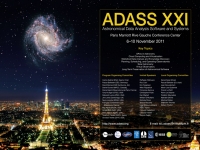Remote Visualization of Large Multi-dimensional Radio Astronomy Data Sets
Pavol Federl (University of Calgary), A. R. Taylor (University of Calgary),
Cameron Kiddle (University of Calgary),
Arne Grimstrup (University of Calgary),
Kevin Robinson (Calgary Scientific),
Matt Stephure (Calgary Scientific),
Gary Yee (Calgary Scientific)
Abstract
The next generation telescopes, such as the Square Kilometer Array (SKA) and Large Synoptic Survey Telescope (LSST), will generate massive data volumes at rates that are magnitudes higher than that of the current telescopes. Unless a radically innovative technology presents itself in the near future to deal with the storage and transport of large data, astronomers will have to start looking for different ways of conducting science that requires processing and visualization. In this paper we describe the design and implementation of an application that is capable of visualizing large remote data sets. It has been developed as part of CyberSKA, a Canadian lead project aimed at exploring and implementing a cyberinfrastructure that will be required to address the evolving data intensive science needs of future radio telescopes.
The main objective of the visualization application is to provide users the ability to interactively explore large multidimensional data sets directly in the browser, without the need to download or install any additional software. An important goal was to replicate as many features and interactivity users are accustomed to in more traditional desktop applications, such as Kvis or DS9. In order to achieve this goal, we had to deal with a number of challenges, such as restricted programing environment supplied by browsers and even more importantly the limited network speeds available to average users.
At ADASS XX in Boston we presented our initial, client-side based visualization tool, which carried out all computation/processing in the Web browser. Unfortunately this tool was not scalable to larger data and it�s design did not make it possible to offer more advanced features, such as playing of movies along the 3rd axis of the data, or dynamic computation of profiles along different axes. We have now implemented a predominantly server-side based visualization approach that eliminated these drawbacks. Just like it�s predecessor, the new version is seamlessly integrated into the CyberSKA Web Portal, where users can easily visualize any data integrated with the portal�s distributed data management system at the click of a button.
To implement the new visualization tool we partnered with Calgary Scientific and utilized their PureWeb technology, which facilitates both re-purposing of legacy server based applications to be used on the Internet, as well as rapid and advanced development of new and fully web-enabled rich GUI applications that manipulate and visualize large remote data sets. The new implementation consists of two distinct parts: client and server code, which communicate with each other through bi-directional connections. The client side code, running entirely within a browser environment, is a thin application which mostly contains code that deals with GUI elements and performs some basic computations that do not require fast data access. The server code, written in C++, implements computations that require large resources and/or fast data access. The results of server operations are compressed and transmitted back to the client for display. The results contain either encoded textual information or streamed JPEG movies.
The new visualization tool supports all of the features of the previous client-based tool as well as a number of new features, which successfully demonstrates the feasibility of our server-based approach. Some of these features include interactive pan & zoom, display of cursor position and grid overlay in different coordinate systems, retrieving data values under the cursor, histogram and colormap adjustments, movie player along 3rd axis, dynamically updating profiles along three different axes, statistical calculations for data in a selected areas and two-dimensional Gaussian fitting. Currently supported data formats are FITS images and CASA visibility data, and more are planned in the future. Through the use of PureWeb technology the new tool also offers advanced collaboration features, where multiple users at geographically different locations can simultaneously view and control the same visualization session. The new tool also runs on a wider range of platforms, such as all major desktop browsers and many iOS and Android mobile devices. The tool is currently being used by the members of the GALFACTS SKA pathfinder project for visualizing spectro-polarimetric image cube data.
Slides in PDF format
Paper ID: O14

